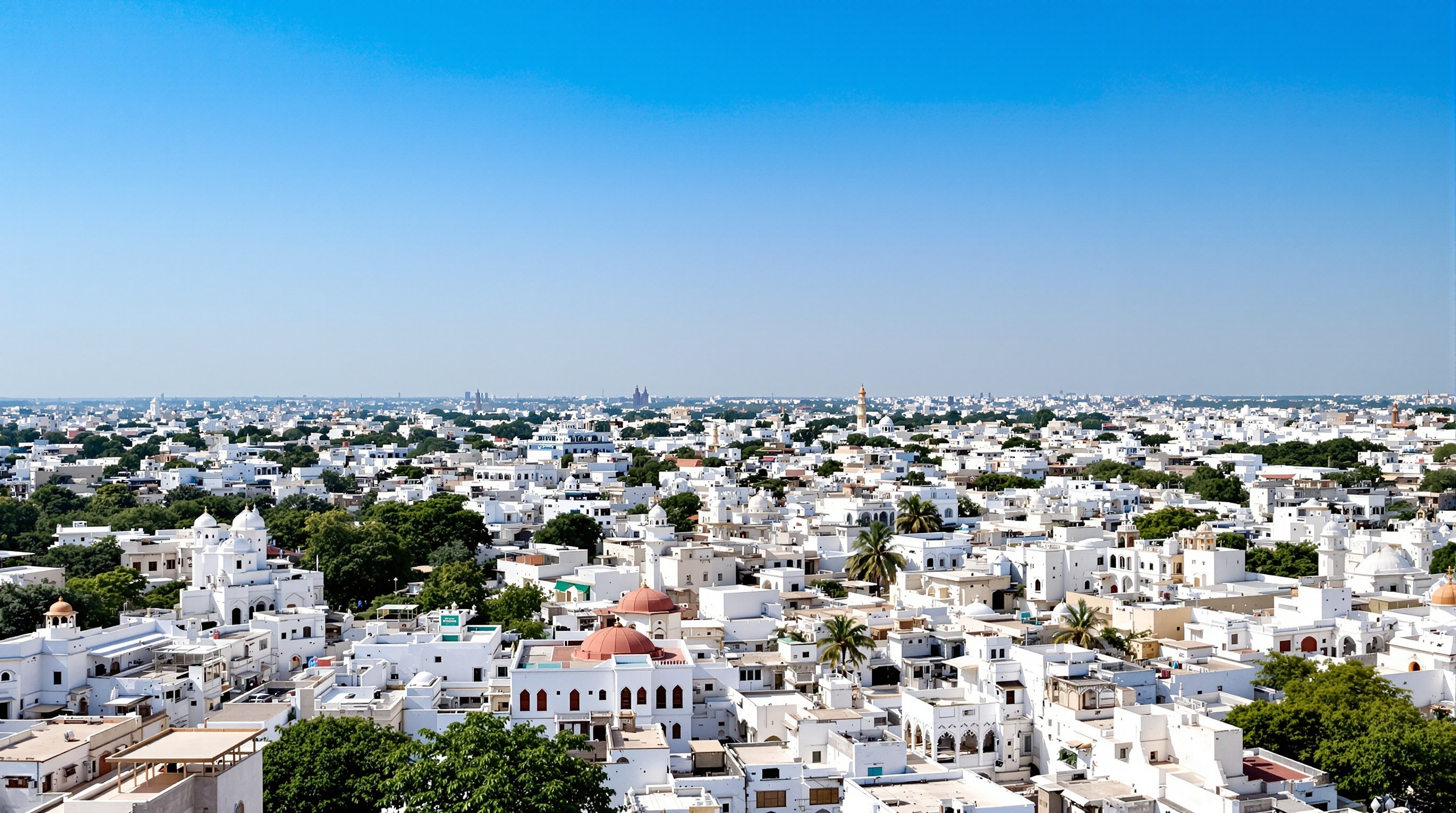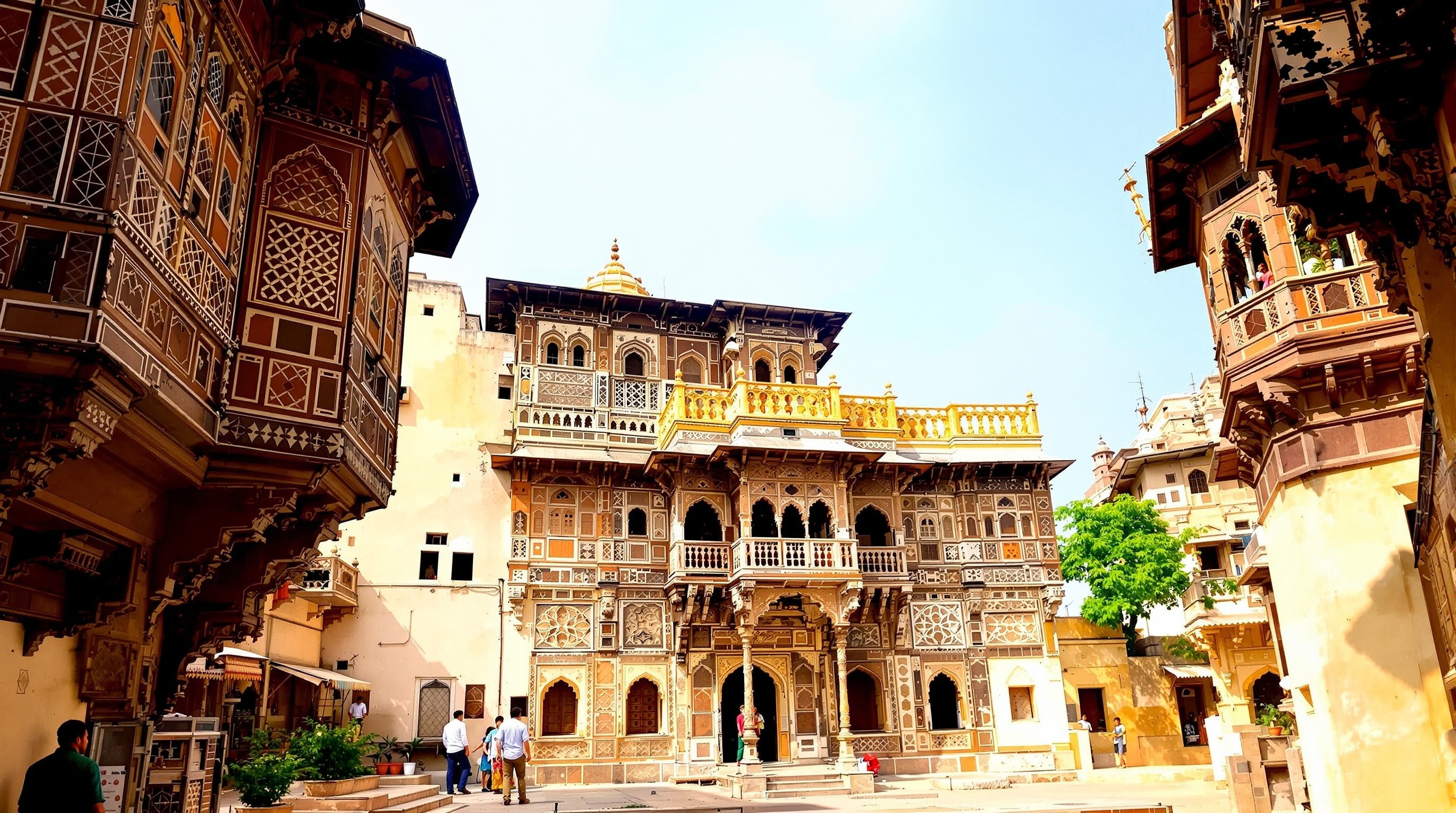Welcome to Bhuj, Gujarat
Discover the Cultural Heart of Kutch
Discover Bhuj: The Gateway to Kutch's Cultural Heritage
Nestled in the westernmost region of Gujarat, Bhuj stands as a testament to the rich cultural tapestry that defines the Kutch region. This historic city, serving as the administrative headquarters of the Kutch district, offers visitors an extraordinary blend of ancient architecture, vibrant traditions, and authentic Gujarati hospitality that has captivated travelers for centuries.

Bhuj city showcasing its unique blend of traditional and modern architecture
Historical Significance and Foundation
The origins of Bhuj can be traced back to 1510 when it was established by Rao Hamirji, a member of the Jadeja dynasty that ruled the region for over four centuries. The city's strategic location at the heart of the Kutch peninsula made it an ideal center for trade, governance, and cultural exchange. Named after the Bhujiyo Dungar hill that overlooks the city, Bhuj has witnessed the rise and fall of kingdoms, survived devastating earthquakes, and emerged as a resilient cultural hub that continues to preserve its heritage while embracing modernity.
The foundation of Bhuj was laid with careful consideration of both defensive and commercial needs. The city was designed around the formidable Bhuj Fort, which served as the royal residence and administrative center. The fort's strategic positioning on the hill provided natural defense advantages while offering panoramic views of the surrounding landscape. Over the centuries, the city expanded beyond the fort walls, developing distinct quarters for different communities, each contributing their unique cultural elements to the urban fabric.
The Jadeja Dynasty and Royal Legacy
The Jadeja Rajputs, who ruled Kutch from 1548 until India's independence in 1947, transformed Bhuj from a modest settlement into a flourishing princely state capital. Under their patronage, the city became a center of art, architecture, and learning that attracted craftsmen, scholars, and traders from across the region. The dynasty's most notable contribution was perhaps their commitment to preserving and promoting the unique cultural identity of Kutch while maintaining diplomatic relations with neighboring kingdoms and the British Empire.
Rao Lakhpatji, who ruled from 1741 to 1760, was particularly instrumental in Bhuj's development. His reign marked a golden period of architectural and cultural renaissance. The Aina Mahal, or Palace of Mirrors, constructed during his rule, stands as a masterpiece of Indo-European architecture that showcases the sophisticated craftsmanship of local artisans. This palace complex, with its intricate mirror work, gold leaf decorations, and innovative engineering features, reflects the cosmopolitan outlook of the Kutch rulers and their openness to international influences.
Architectural Marvels and Urban Planning
Bhuj's architectural landscape presents a fascinating study in cultural synthesis, where traditional Indian design principles blend seamlessly with Islamic, European, and local Kutchi elements. The old city area, characterized by narrow winding streets, ornate havelis (traditional mansions), and intricately carved wooden facades, represents the pinnacle of vernacular architecture adapted to the harsh desert climate. These structures, built using locally available materials like sandstone, timber, and clay, demonstrate the ingenuity of local craftsmen who developed construction techniques suited to the region's extreme weather conditions.
The city's urban planning follows traditional Indian principles of city design, with separate areas designated for different communities and commercial activities. The main bazaar area, centered around the historic Darbargarh Palace, evolved organically as the commercial heart of the city. Here, traditional shop houses with their characteristic overhanging balconies and carved wooden pillars continue to serve as both residences and places of business, maintaining the living heritage of the region's trading traditions.
Cultural Renaissance and Artistic Heritage
Bhuj has long been recognized as a cradle of traditional arts and crafts, nurturing numerous craft traditions that have been passed down through generations. The city's patronage of arts under royal sponsorship created an environment where craftsmen could develop their skills to extraordinary levels of sophistication. The famous Kutch embroidery, with its intricate mirror work and vibrant thread patterns, originated and evolved in the workshops of Bhuj, where royal ladies would commission elaborate garments and household textiles.
The tradition of miniature painting, which flourished under royal patronage, produced exquisite works that documented court life, historical events, and religious narratives. These paintings, characterized by their delicate brushwork and vivid natural pigments, provide valuable insights into the cultural and social life of the region during different historical periods. Many of these artistic treasures are preserved in the city's museums and private collections, offering visitors a glimpse into the refined aesthetic sensibilities of the Kutch court.

Traditional architecture showcasing Bhuj's rich cultural heritage
Religious Harmony and Spiritual Centers
One of Bhuj's most remarkable features is its tradition of religious tolerance and the peaceful coexistence of multiple faiths. The city is home to numerous temples, mosques, churches, and other places of worship that reflect the diverse spiritual traditions of its inhabitants. The Swaminarayan Temple, with its elaborate carvings and peaceful atmosphere, stands as a testament to the city's commitment to spiritual values and architectural beauty.
The Sufi tradition has also left an indelible mark on Bhuj's cultural landscape. The dargahs (shrines) of various Sufi saints serve not only as places of pilgrimage but also as centers of cultural exchange where people of different faiths come together to seek blessings and participate in the qawwali music traditions. This syncretic approach to spirituality has contributed to the development of a unique cultural ethos that emphasizes harmony and mutual respect.
Trade and Commercial Heritage
Bhuj's strategic location on ancient trade routes connecting Gujarat with Sindh, Rajasthan, and beyond made it an important commercial center for centuries. The city's merchants established extensive trading networks that extended to Central Asia, the Middle East, and East Africa, bringing prosperity and cultural exchange. The traditional bazaars of Bhuj, each specializing in different commodities, continue to reflect this commercial heritage.
The spice market, textile bazaar, and jewelry quarter each have their distinct character and traditions, passed down through generations of merchants. The practice of community-based trade guilds, which regulated commercial practices and maintained quality standards, contributed to the development of a sophisticated commercial culture that balanced profit motives with social responsibility. These traditions continue to influence the city's commercial life, where modern business practices coexist with traditional values.
Educational and Intellectual Traditions
Bhuj has historically been an important center of learning and intellectual activity in the region. The establishment of Sanskrit schools, madrasas, and libraries under royal patronage created an environment where knowledge could flourish. The famous Ramkund library, established in the 18th century, housed an extensive collection of manuscripts on various subjects including astronomy, mathematics, medicine, and philosophy.
The tradition of scholarly debate and intellectual exchange attracted learned individuals from across the region, making Bhuj a hub of intellectual activity. This legacy continues today with the presence of educational institutions that maintain high standards of academic excellence while preserving the region's cultural values and traditions.
Natural Environment and Geographical Significance
The geographical setting of Bhuj, situated between the Great Rann of Kutch and the Gulf of Kutch, has played a crucial role in shaping its development and character. The city's elevation provides protection from seasonal flooding while offering commanding views of the surrounding landscape. The nearby hill ranges, covered with thorn forest vegetation, support a variety of wildlife and serve as important watersheds for the region.
The unique ecosystem of the Kutch region, with its seasonal wetlands and salt deserts, creates a landscape of extraordinary beauty that transforms dramatically with the changing seasons. This natural environment has not only provided resources for the city's inhabitants but has also inspired artistic and literary traditions that celebrate the region's natural heritage.
Modern Development and Urban Challenges
In recent decades, Bhuj has undergone significant transformation as it adapts to modern requirements while attempting to preserve its cultural heritage. The devastating earthquake of 2001, which caused extensive damage to the city's historic fabric, also provided an opportunity for reconstruction and renewal. The rebuilding efforts, guided by principles of sustainable development and heritage conservation, have created a unique urban environment where traditional and contemporary elements coexist.
The development of modern infrastructure, including transportation networks, educational institutions, and healthcare facilities, has improved the quality of life for residents while maintaining the city's cultural identity. This balanced approach to development serves as a model for other historic cities facing similar challenges of modernization and heritage preservation.
Festivals and Cultural Celebrations
Bhuj's calendar is marked by numerous festivals and cultural celebrations that reflect the city's diverse traditions and community spirit. The Rann Utsav, a cultural festival celebrating the unique heritage of Kutch, attracts visitors from around the world to experience traditional music, dance, crafts, and cuisine. This festival, held annually in the nearby White Desert, showcases the best of regional culture while providing economic opportunities for local artisans and performers.
The traditional Hindu festivals of Diwali, Holi, and Navratri are celebrated with great enthusiasm, involving the entire community in elaborate decorations, music, dance, and feasting. The Muslim festivals of Eid and Muharram are observed with equal fervor, demonstrating the city's commitment to religious harmony and cultural pluralism. These celebrations serve not only as religious observances but also as important social events that strengthen community bonds and preserve cultural traditions.
Preservation Efforts and Cultural Continuity
Recognizing the importance of preserving its cultural heritage for future generations, Bhuj has witnessed numerous initiatives aimed at documenting, conserving, and promoting traditional arts, crafts, and architectural heritage. Local organizations, supported by government agencies and international partners, have established museums, cultural centers, and training programs that ensure the continuity of traditional knowledge systems.
The documentation of oral histories, traditional practices, and craft techniques has created valuable resources for researchers and cultural enthusiasts. These preservation efforts, combined with educational programs that introduce young people to their cultural heritage, ensure that the unique traditions of Bhuj continue to thrive in an increasingly globalized world.
Today, Bhuj stands as a living museum of Gujarati culture, where ancient traditions coexist with modern aspirations. The city's ability to adapt to changing circumstances while maintaining its cultural identity serves as an inspiration for other historic cities facing similar challenges. For visitors, Bhuj offers not just a destination but an immersive cultural experience that provides insights into the rich heritage of Gujarat and the remarkable resilience of its people.